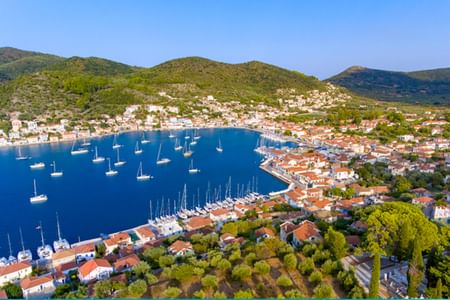It is time for a full day tour which covers many important spots of Athens, all packed at a private basis. Visit the Acropolis, the Acropolis Museum, the Temple of Olympian Zeus, the Ancient Agora, the Temple of Hephaestus, the Panathenaic Stadium, the National Archaeological Museum and the Tomb of the Unknown Soldier between all. Entrance fees at own expense. Serves as an ideal choice for travelers who like to check the sights off without delay enjoying privacy. Onboard Wi-Fi lets you stay connected with everything and share as you go.
Athens Full Day Private Tour
About This Tour
Inclusions
- Air-conditioned vehicle
- Private transportation
- Bottled water
- (With option to have lunch at a traditional greek tavern)
- Hotel pickup and drop-off
- Food & drinks
Exclusions
- Licensed tour guide - upon request and prone to availability
- Tips
- Airport pickup and drop-off (can be booked with extra cost)
- Admission tickets to archaeological sites
Tour Plan
Itinerary
Starting with a pick up from Athens airport, hotel, airbnb or apartment.
Starting with walking to Acropolis, an ancient citadel located on a rocky hill in Athens, Greece. It is best known for its classical buildings, particularly the Parthenon, which was dedicated to the goddess Athena. The Acropolis is a symbol of ancient Greek culture, democracy, and architectural achievement, and it has been a UNESCO World Heritage site since 1987.
The Propylaea refers to the monumental gateway that serves as the entrance to the Acropolis of Athens. The structure is notable for its grand scale and architectural innovation. It was designed to be a grand entranceway, not just for practical purposes but also as a symbol of the power and cultural significance of Athens.
The Parthenon is a classical Greek temple dedicated to the goddess Athena, built between 447 and 438 BCE on the Acropolis of Athens. It is considered the pinnacle of Doric architecture and a symbol of the power, culture, and democracy of ancient Athens. The Parthenon is renowned for its stunning proportions, refined details, and the optical illusions in its design that give it a harmonious, balanced appearance. Though partially damaged over the centuries, it remains one of the most iconic structures of ancient Greece.
The Erechtheion is an ancient Greek temple on the north side of the Acropolis of Athens in Greece which was dedicated to both Athena and Poseidon.
The Temple of Athena Nike is a small yet exquisite Ionic temple located on the southwest corner of Acropolis, built around 427–424 BCE. It is dedicated to the goddesses Athena and Nike, the latter representing victory. The temple is renowned for its graceful proportions and elegant design. One of its most famous features is its frieze, which depicts scenes of battles and triumphs.
The Temple of Athena Nike was also a symbol of Athens' power and its belief in divine favor for their military success. It’s often celebrated for its delicate yet bold aesthetic and for being one of the few temples without any stairs, reflecting its unique function and position.
The Theatre of Dionysus is an ancient Greek theater located on the southern slope of the Acropolis in Athens, near the Temple of Dionysus. It is considered the birthplace of Greek drama and one of the earliest theaters in the world, with origins dating back to the 6th century BCE. It was dedicated to Dionysus, the god of wine, fertility. The theater could originally hold up to 17,000 spectators, making it one of the largest theaters of its time. It remains a symbol of Athens' cultural and artistic legacy.
The Odeon of Herodes Atticus is a stone Roman theater structure located on the southwest slope of the Acropolis of Athens.
The Acropolis Museum is an archaeological museum that opened in 2009 and is dedicated to the archaeological findings of the Acropolis of Athens. The museum houses a vast collection of sculptures, pottery, and artifacts from the Acropolis. The museum is renowned for its modern and sleek design, with large glass walls offering views of the Acropolis and its surrounding areas. The museum also provides important insights into ancient Greek art, culture, and religious practices, with exhibits arranged in a way that follows the layout of the Acropolis itself.
The Arch of Hadrian is an ancient monument, built in 131 CE to honor the Roman emperor Hadrian. The arch marks the boundary between the old city of Athens and the new Roman district. The structure is an impressive example of Roman architecture, with its grand, monumental archway and inscriptions on both sides.
The Temple of Olympian Zeus, also known as the Olympieion, is a massive ancient temple in Athens dedicated to the king of the Greek gods, Zeus. Initially it had 104 Corinthian columns, of which only 15 remain today. The temple was one of the largest in the ancient world and symbolized the power of Zeus and the Roman influence on Greece.
The Panathenaic Stadium, also known as Kallimarmaro, is an ancient stadium in Athens, Greece, famous for being the site of the Panathenaic Games, held in honor of the goddess Athena. The stadium hosted athletic events and it is unique for being constructed entirely of marble, and it could hold up to 50,000 spectators. The stadium is still in use today for various events and is also a key historical site,.
We continue with driving up to Lycabettus hill where you will enjoy the beautiful panoramic view of the city and admire the combination of ancient and modern Athens from above.
Syntagma Square is a central and iconic public square in Athens, Greece. It is located in front of the Greek Parliament building, which was originally the royal palace. The name "Syntagma" means "Constitution" in Greek. The square is a hub for both locals and tourists, with important landmarks around it, including the National Garden and luxury hotels.
The Hellenic Parliament, located in Athens, Greece, is the legislative body of the country. It occupies the former Royal Palace, a neoclassical building constructed in the 19th century. It is a key institution in Greece's democratic system, where lawmakers debate and pass laws. The Parliament building is an important landmark in Athens and is situated in Syntagma Square, right next to the Tomb of the Unknown Soldier and the changing of the guard ceremony.
The Tomb of the Unknown Soldier is a solemn monument located in front of the Greek Parliament in Syntagma Square, Athens. It honors Greek soldiers who died in battle, their identities unknown. The tomb features an inscription that reads "Unknown Soldier," and it is guarded by the elite presidential guards, the Evzones. These guards, in traditional uniform, perform the ceremonial Changing of the Guard every hour, a popular attraction for visitors.
The Academy of Athens is one of Greece’s most prestigious academic institutions, founded in 1926. Located in the heart of Athens, it is housed in a neoclassical building designed by architects Theophil Hansen and Christian Hansen. The Academy serves as a center for scientific research and academic excellence. It is part of the "Athenian Trilogy," a group of neoclassical buildings that also includes the University of Athens and the National Library.
The National and Kapodistrian University of Athens (NKUA) is the oldest and largest university in Greece, founded in 1837. It is named after Ioannis Kapodistrias, the first governor of independent Greece. Located in the heart of Athens, the university is a leading academic institution, offering a wide range of undergraduate and graduate programs in various fields, including humanities, sciences, engineering, and social sciences.
The Old Parliament House at Stadiou Street in Athens housed the Greek Parliament between 1875 and 1935. It now houses the country's National Historical Museum, which is dedicated to preserving and showcasing Greece's rich history.
The National Archaeological Museum in Athens is one of the most significant museums in the world, dedicated to ancient Greek art and archaeology. It houses an extensive collection of artifacts from prehistoric to Roman Greece, offering insight into the development of Greek civilization. Totally a must-visit for anyone interested in ancient Greek history and culture.
Time to relax a little bit with free time for lunch at a Greek traditional tavern or instead go shopping.
The Ancient Agora of Athens was the heart of public life in ancient Athens, serving as a marketplace, meeting place, and center for political, commercial, and social activities. Located just northwest of the Acropolis, the Agora was also a place where famous philosophers like Socrates and Plato gathered to discuss ideas. It played a key role in the development of Athenian democracy and remains a significant archaeological site today.
This small museum offers a glimpse into the daily life, politics, and culture of ancient Athens.
The Temple of Hephaestus is an ancient Greek temple located in the Agora of Athens. It is dedicated to Hephaestus, the god of metalworking, craftsmanship and fire. It is an iconic example of classical Greek architecture and offers a glimpse into the religious practices of ancient Athens.
Plaka is a historic neighborhood in the heart of Athens, located just beneath the Acropolis. Known for its charming, narrow streets, neoclassical buildings, and vibrant atmosphere, Plaka is often called "the neighborhood of the gods" due to its proximity to ancient landmarks. It is a popular area for both locals and tourists, offering a mix of traditional tavernas, shops, cafes, and cultural sites. With its blend of old-world charm and modern-day liveliness, Plaka offers a unique glimpse into Athens' rich history and culture.
Meeting / Pickup
Know Before You Go
- Wheelchair accessible
- Stroller / pram accessible
- Infant seats available
- Passport required
Please Note
- Not suitable for pets
- No public transportation nearby
- Infants must not sit on laps
- Wheelchair accessible
- Not wheelchair accessible
- Not recommended for people with heart conditions
- Our driver will be waiting for you holding a sign with the clients' names.
Reviews
Save 11%
🎁 First Time Booking-
Limited Time Offer: All Dates, All Destinations
















